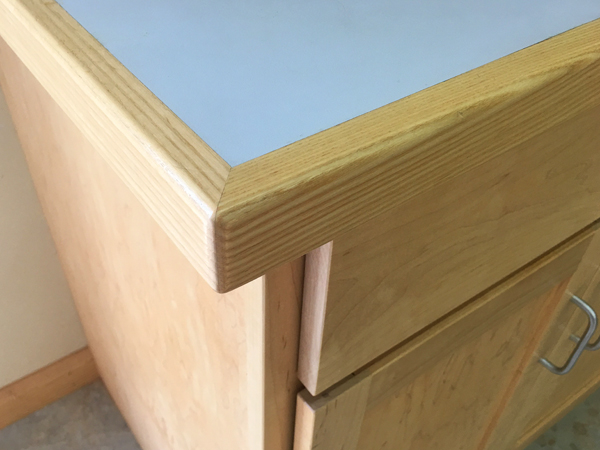
I would like to make a curved edge on my kitchen counter — two edges and a curve around the corner. I would like to follow this with a roundover router pass on the top edges. Will I see glue lines after the router cut? – Lee Walkowski
Chris Marshall: Without a drawing or a more thorough description, Lee, what would be helpful to know is how you intend to build the substrate for your countertop (the material that builds up the countertop’s thickness underneath the top work/wear surface). And then, what sort of lipping you plan to install on the edge of the substrate that will serve as the surface you’ll be routing into around the curve. Even knowing how large the radius of the curve will be would be helpful to know (are we talking a 1/2-in. radius curve or a 10-in. radius?). As is, we don’t have great deal to go on here to offer advice.
If you’re planning to install a solid-surface countertop, then there won’t be any glue lines, because you won’t be gluing the sheets together at the curve. On the other hand, if you’ll be building up a more typical chipboard or plywood substrate, then banding the edge with solid wood and covering the top with plastic laminate, it’ll be tough to completely hide glue lines around the edge when you rout the roundover. I suppose you could laminate a bunch of thin strips of solid wood around a form to create the curved portion of the lipping (glues lines would be on the top and bottom edges of this curve instead of on the curved face), but you’ll still see a few long glue lines when you rout the top edge roundover and expose some of the laminated edge. If you do a really careful job of creating this lamination, the glue lines would be minimally noticeable and might even add some dynamic to the look of the countertop’s edge.
In my shop, I built a countertop with lipping made of solid ash and gray plastic laminate as the work surface (see photo). My substrate was two sheets of built-up MDF behind the ash lipping. The outside corner is mitered, and there’s a roundover on both the sharp mitered corner and the top edge to make it more durable and “skin friendly.” Of course I can see the glue line where the mitered pieces come together, but I think this looks pretty good, and it’s a logical intersection of two parts. When a glue line is an unavoidable intersection, I don’t see any need to hide it, so long as the pieces come together in a tight, neat seam. To me, that’s just good craftsmanship–not a mistake or a blemish to be hidden.






